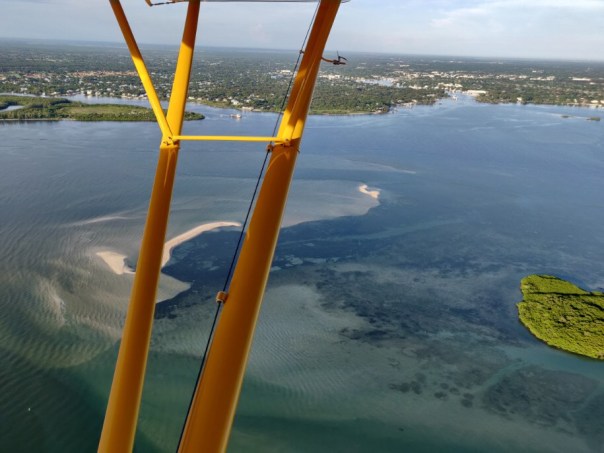
On August 3rd, I posted the above aerial noting the return of visible recovering seagrasses since the ACOE stopped discharging from Lake Okeechobee.
One of my readers wrote: “Most is not true seagrass, some algae’s, discolored sand. A little shoal grass here and there. It’s gonna take a few years of no discharges.”
And this is true. Seagrass is growing back, but right alongside, or even on the algae itself, is something else. A type of dark green, slimy-algae covering the grasses. I don’t remember it like this before…
We are living in a time of over-nitrification. Too much Phosphorus and Nitrogen drains off the land into the estuary feeding algae of all kinds as they compete for dominance.
And we decide who wins:
~A great video shared by my brother Todd covering the story of all types of algae and cyanobacteria.


I have seen the microalgae growing back on our seagrasses in the SLR/IRL, and it has been here for years; it is just getting more dominant. I have not photographed as doing so requires a protected camera. Thus I am sharing these photos that in some ways resemble our beds.


And we need to start cleaning all the muck off the bottom of the St. Lucie River and the St. Lucie Canal now, so the seagrasses and bottom organisms are no longer smothered. If we start doing that right away, the impact of future discharges will be slightly lessened, and the bottom ecosystems can be re-established. But the discharges need to be permanently stopped too. I am so worried they will “cure” the algae blooms but leave the biggest problem untouched which is the rapid discharge of billions of gallons of fresh water, laden with biosolids and chemicals which are deposited on the bottom and make our river black. Yes, it starts to look better near the inlet sooner, but it will never heal up the river unless we take out the decades of muck deposits which are 10-12 feet deep in spots. It needs to be removed and sent back to the farmers who can use it.
Don’t worry, Mac. They won’t cure this unless there is a literal sea change in Florida – political and invoking the evil R word, not Republican but Regulation.
Dear Jacqui,
I know things are far from good. But I cannot express how happy I am that you are on the SFLWMD. At least I feel we now have someone in our corner. Thank you for all your efforts.
Nadine Baker Venice, FL
On Mon, Aug 5, 2019, 1:38 PM Jacqui Thurlow-Lippisch wrote:
> Jacqui Thurlow-Lippisch posted: ” On August 3rd, I posted the above aerial > noting the return of visible recovering seagrasses since the ACOE stopped > discharging from Lake Okeechobee. One of my readers wrote: “Most is not > true seagrass, some algae’s, discolored sand. A little shoal ” >
Thank you!!! Yes we are moving towards the light
If you had hard coquina on shore macroalgae would heap up on it and desolve it. It is like a fruit in that just before it dies creatures can eat it — I think it is essential for large blue crab populations. Be prepared—-if it heaps up in pockets on the shore it can rot and make the whole town smell like crap.
Guess who